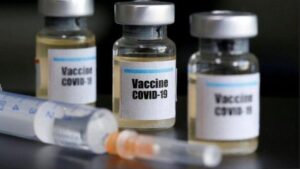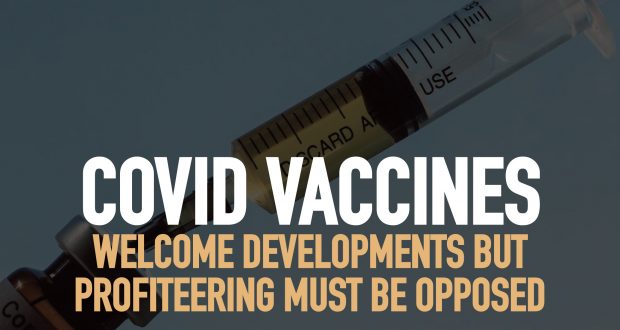The vaccine should be free to all on the basis of need, risk of exposure, and risk of serious illness, not on ability to pay.
Keishia Taylor, Socialist Party (ISA Ireland)
Ten months after the novel coronavirus erupted around the world, after 58 million cases and 1.4 million deaths (by 23rd November 2020), we now face a collision of COVID-19 with the winter flu season. The R-rate in the US is worse than ever, before Thanksgiving, Black Friday and Christmas have even begun. In Ireland, our collapsing health system is overwhelmed in a normal winter, let alone after over 2000 COVID-19 deaths and with medical staff stressed, exhausted and self-isolating with the virus. The seriousness of “long Covid,” causing severe symptoms even months after recovery, continues to be unearthed.
While governments globally are hailing the various vaccines that have come into existence, which will come as an undoubted relief to working-class people who have borne the brunt of this pandemic, the Covid-19 crisis is going from bad to worse. Tragically, this crisis will deepen further before it ends due to the inaction of capitalist regimes globally, and the widespread failure to put in place proper test and tracing systems, and the refusal to curtail economic activity. They are determined to prioritise the interests of businesses over our health and safety.

Extremely positive results from four vaccine candidates have been announced in the space of a fortnight, and more news continues to break. Pfizer / BioNTech and Moderna Therapeutics vaccines were 90% and 94.5% effective in Phase 3 trials, and the Russian Sputnik V vaccine claims to be 92% effective albeit at an earlier testing phase. This was followed by the news that the Oxford University / AstraZeneca vaccine produces a strong immune response in adults over 70. This far surpasses expectations, as a vaccine that was 50-70% effective would still have been a game-changer in our battle against the coronavirus. The CEO of BioNTech says their vaccine will “bash the virus over the head.”
This is a testament to modern science, advanced technology, the ingenuity of the best immunologists and the incredible dedication of research resources to this one goal. But we are not out of the woods yet – it must still be mass-produced, distributed and administered to billions of people. Is global capitalism up to the task?
A silver bullet?
The news was met with celebration and relief; there is now seemingly light at the end of the tunnel. Taoiseach Micheál Martin has promised that the vaccine will be available to the Irish public by mid-2021, and economist, David Williams, has said that between low interest rates, Brexit and now the vaccine, Ireland has a golden opportunity to repair the economy. The world capitalist markets are certainly optimistic, with stocks in pharmaceutical companies, airlines, hotels and cinemas soaring and shares in Zoom plummeting — these parasitic speculators are investing where they think profit margins will rise. But public health officials are more cautious; Dr Tony Holohan described the results as “hopeful” but “too early to celebrate.”
Both the Pfizer / BioNTech candidate, BNT162b2, and Moderna’s candidate use an experimental mRNA-based technique that involves injecting part of the virus’s genetic code into the body to train the immune system to produce the right antibodies and T-cells. This is much quicker than the traditional method, which is part of the reason why vaccine candidates could be developed in ten months rather than years. This new approach could prove very useful in the future as well, as we are unfortunately likely to face more pandemics in the years ahead.
These two vaccines are both in Phase 3 trials with large sample sizes designed to find rare side effects that were not evident in Phase 1 and 2 trials. The Moderna trial involved around 30,000 participants who received two doses of either the vaccine or a placebo and 94.5% of the COVID cases that have occurred were in the placebo group. Similarly, the Pfizer trial injected 40,000 people and of the first 94 cases, 90% of COVID cases occurred in the placebo group. No serious safety concerns arose, and the results are extremely positive so far, but the studies have not yet been subject to rigorous peer-review.
Both vaccines are still being trialed and some questions are not yet answered with certainty. Protection from COVID-19 is achieved 28 days after the first of two doses but could last from six months to several years, requiring boosters at unknown intervals. Older people have been included in the trials, but not in large enough numbers to understand how their depleted immune systems respond to the vaccine. It is also possible that side effects could emerge among people with rare characteristics, or over a long period of time, although that is unlikely. The virus can also mutate, as seen with the outbreak among farmed mink in Denmark, which suggests regular vaccinations against the newest strains, like with seasonal flu. But even an imperfect vaccine could have a huge impact in reducing illness and death.
At the moment, it is unclear whether the vaccines prevent infection with the SARS-CoV-2 virus, or only the onset of COVID-19 disease. Establishing whether it can stop asymptomatic infections could take up to a year but is an extremely important factor in developing herd immunity. The exact percentage of the population that must be resistant to infection to achieve herd immunity is also unknown at this time, so large-scale testing is likely to be required long into the future.
Logistics of distribution
Even when the vaccines are approved, billions of people must receive two doses of the vaccine – that means two separate visits to a health centre or vaccination site, which presents difficulties for people even in wealthy nations as well as the billions in neo-colonial countries. The leap forward in vaccine development has not been matched by investment in cooling technology and infrastructure. The Pfizer vaccine must be stored at a temperature of minus 70-80 degrees, requiring an ultracold freezer that costs five times more than a standard freezer, and beyond the facilities typically available to GPs and pharmacists even in advanced countries. Other vaccines, such as the Moderna candidate, only requires normal refrigeration at 2-8 degrees, but they still need non-stop sterile refrigeration to stay potent and safe from factory to syringe. This requires mobile refrigeration, reliable electricity, reliable transportation, and sufficient medical staff to quickly administer batches of vaccines.
Nearly three billion of the world’s 7.8 billion people live where temperature-controlled storage is inadequate for an immunization campaign to defeat COVID-19. The WHO estimates that globally half of vaccines are lost to heat exposure, vials breaking in transit, or even theft. Already, a child dies every 20 seconds from a disease that could have been prevented with a vaccine. The obscenely unequal nature of global capitalism means that poor and neo-colonial countries that have been ravaged by the virus are likely to be the last to recover from it.
Business opportunities
The development of a new vaccine, from lab to market, typically takes 10-15 years, and the fastest ever, the mumps vaccine in the 1960s, took four years. But these vaccines are at advanced testing stages in less than a year, in large part due to the immense resources that pharmaceutical companies have received from various governments, particularly the US. Médecins Sans Frontières (MSF) reported that the Pfizer / BioNTech vaccine development has received $2.5 billion, Moderna $2.48 billion and AstraZeneca / Oxford University candidate $1.7 billion from state funds. The Pfizer / BioNTech partnership stands to make $13 billion profit from their vaccine. Despite unprecedented taxpayer funding, these private companies retain control over the price and quantity of vaccine produced and who they will sell it to. The idea that it is an efficient “hidden hand” of the private capitalist market that delivers for our needs is a myth, they simply reap the rewards from a system of corporate welfare that governments globally have set up for them.
Other companies, such as AstraZeneca and Johnson & Johnson, have pledged to make their vaccines available on a not-for-profit basis during the pandemic, with doses costing $3-5 rather than the $35 that Moderna is expecting to charge. But the veneer of goodwill is thin – when the pandemic has waned, they can ramp up the price. It is likely that annual shots will be needed to maintain immunity, which could make AstraZeneca $10 billion per year.
India and South Africa have proposed that World Trade Organisation member states be allowed to waive patents and other intellectual property rights on Covid-19-related treatments, including vaccines, until the end of the pandemic. This would allow manufacturers all over the world to produce generic Covid-19 vaccines, treatments, and tests without being sued or prosecuted. But the UK, US, Canada, Australia and the EU, all of which have already secured billions of doses, have opposed this. The UK claims that waiving the IP rights set out in the TRIPS [Trade-Related Intellectual Property Rights] agreement is too extreme and would be counterproductive.
The pursuit of profit, whether short or medium-term, is dictating the development, production, regulation and distribution of Covid-19 vaccines, not the health or lives of billions of people. As Oxfam has argued, the vaccine is “zero per cent effective to the people who can’t access or afford it.” The masses of humanity are reliant for a vaccine on pharmaceutical companies and the governments of the wealthiest and most developed and influential capitalist states whose aim is profit and power. Healthcare companies should not be run for private profit, their resources must be seized and brought into public ownership globally, under the democratic control of the working class and poor masses.
Who’s first?
The most developed capitalist countries, accounting for 13% of the world’s population, have pre-ordered the majority of the doses due to be produced in 2020 and 2021. The US has a $2 billion contract with Pfizer for 100 million doses by the end of the year, and a further agreement for 1.3 billion doses by the end of 2021 – twice the amount needed for everyone in the US. The European Commission has secured at least 1.1 billion doses of four different vaccines, including the Pfizer / BioNTech and Oxford / AstraZeneca vaccines, which significantly exceeds the number of doses required for the population of the EU. The pre-orders of rich countries largely correspond to the maximum possible production of vaccines next year, leaving the majority of the populations of poorer nations to deal with the pandemic without a vaccine. This has been termed “vaccine nationalism” but is a normal feature of ruthless, profit-hungry, capitalist competition. And the scarcity of vaccine doses is avoidable – it is manufactured by international property and patent laws that restrict production while geopolitical capitalist rivalries place a severe limit on global cooperation.
There will undoubtedly be a multitude of complications. False information about the protective properties of mouthwash[xviii], for example, against coronavirus is recirculating online which may distract from scientific treatments, and a minority of the public hold anti-vaccine conspiracist beliefs. A recent survey in Ireland found that 12% of respondents would not take a vaccine and 33% were unsure. Anti-vax and conspiracy theory ideas are often rooted in a deep distrust of the establishment, which is completely understandable, after repeated betrayal, hypocrisy and incompetency demonstrated by successive capitalist governments. Aside from the recent Golfgate and Leo the Leak scandals, 600,000 doses of seasonal flu vaccine have gone missing and the Department of Health neglected to specify any funding for Covid-19 vaccines in 2021’s budget.
An immunisation programme will require a phased approach, even in wealthy countries. Some states, such as the US and Ireland, have indicated that they will prioritise healthcare workers and other essential frontline workers, older people and those with health conditions that place them at higher risk. In Ireland, teachers who are facing high risks of infection by working in the classroom, have already and correctly demanded that they are considered frontline workers, and are getting ready to fight for their health, safety and conditions. But who should ultimately decide who is vaccinated first? Politicians and elites who throughout the pandemic have been able to access the best possible healthcare, or committees of workers, including the young, old and sick, who can democratically agree a plan according to public need and risk?
What is needed
The vaccine should be free to all on the basis of need, risk of exposure, and risk of serious illness, not on ability to pay. It should be democratically distributed across the globe on the basis of need, with the aim of eliminating sickness and death from Covid-19 and using mass vaccination to achieve population immunity in the shortest possible time. Leaving control over the vaccine in the hands of big pharma and governments is sure to result in unnecessary sickness and deaths. Biotech and pharmaceuticals, along with research institutes, should be brought into public ownership and control to be used in the interests of the masses, not the profits and power of a handful of elites.
Working-class organisations, trade unions and social movements should organise to demand a free vaccine for all, fight to abolish medical patents, and for free, quality, public healthcare. There has already been valiant struggle during the pandemic, for health and safety, against job losses and for fair redundancies, against racist and sexist oppression, and as we face a global depression, mass unemployment and social and political crises, we can expect much more, with the potential of far-reaching consequences. The vaccine provides hope — there is light at the end of the tunnel, but for many it is still a long way off.
The Covid-19 crisis has shined a light on the plethora of inequalities and injustices that exist within the capitalist system we live under. It is the working class, the poor and the oppressed that have been hit disproportionately by this pandemic, while the super-rich have had the option of hiding away on their private islands, yachts and mansions. This grotesque system must go. Only a united struggle of the global working class, poor and oppressed can build the post-Covid future that we need and deserve — a socialist future where the world’s wealth and resources are publicly owned and utilised to serve the interests of the majority.




